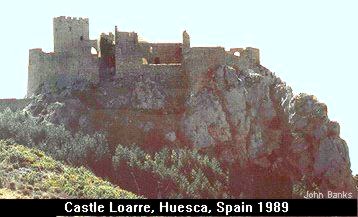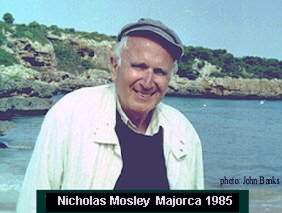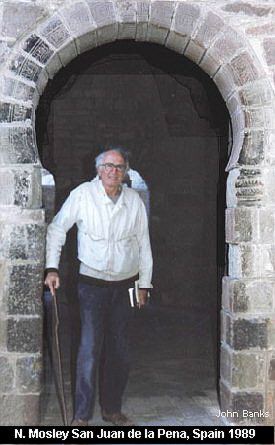

During the visit in 1989 Mosley was working on the final
draft of Hopeful Monsters, and on the return trip to England (through
Spain and France by caravan) we stopped at the two Spanish historical sites
which were very important settings of his story: Castle Loarre and the
monastery San Juan de la Peña, in Aragon (where the Holy Grail was
said to have been kept for a time and on one of the pilgrimage routes to
Santiago de Compostela ). The novel had been an enormous undertaking, and
as it was the last of the linked “Catastrophe Practice” books - their “culmination”,
so to speak - it would undoubtedly be one of his major works.
After my return to Canada I began to think that if there
were ever to be any film or video documenting of Mosley’s life then it
should be started before he left the villa: aside from its significance
to him (and to me), it was a filmmaker’s dream location. However there
was no evidence that anyone whose business it is to make documentaries
had any interest in such a project. It happened that a younger friend
of mine, John Corry, who had studied literature and was interested in Mosley’s
writings, was soon to be finishing his courses in filmmaking at the university.
He was ready for such an adventure, and Mosley was willing, so early in
1990 it was all arranged. At the time the videomaking seemed to be a natural
extension of the work I was already doing - I would be visiting him again
anyway - and taping discussions was not a great task. My original plan
was to acquire the video material “for posterity”, but then Hopeful
Monsters won the Whitbread Prize and it became reasonable to acquire
material that would be useable for television broadcast. This required
more planning, more taping, and much more attention to what are called
the “production values”.
| The first sessions, in the Spring of 1991 (at the villa,
the picturesque cottage in Sussex, and in Mosley’s Hampstead apartment),
yielded about fourteen hours of material, covering a very wide range of
topics: his early years and war experiences, the evolution of his approach
to writing, and links between his work and topics in philosophy and science.
(Clearly little of this could be included in a fifty-minute program.) In
the mornings, before the daily taping sessions, Mosley was working on his
autobiography Efforts at Truth and a treatment for a film version
of Hopeful Monsters, consequently most of the taping did simply
document the sort of talk that is part of “work in progress” - especially
as it became easier to ignore the camera and the technical inconveniences.
The publicity generated by Hopeful Monsters did not stimulate any serious interest among broadcasters, and I did not have the large funds needed for elaborate post-production, so for a few years the tapes were set aside. However in 1995 I was able to take advantage of the developments in computer and video technology which were making it possible to edit videotape for comparitively little cost (except of time, of course). In 1997 I visited Mosley again, with Yolande du Gardein-Matson, and we taped a further eight hours of material - which is again very wide-ranging - and some of this is included in “Nicholas Mosley: Writing Life.” This program was designed to serve as an introduction to Mosley’s views and to his approach to writing, for a general, discerning audience, however it is unlike most biographical profiles of authors: I believed that - whenever it was possible - Mosley's story should be told through his own words, that in this way the style of the program might be fitted to the style of his writing, which is to engage the reader in the process of making connections. |
 |
|
|
|
|
| All contents of this website except those marked "copyright Nicholas Mosley" are the property of John Banks. Please acknowledge the source of any brief quotations which you may wish to use. Any other use of the contents of this website without written permission is an infringement of copyright. |